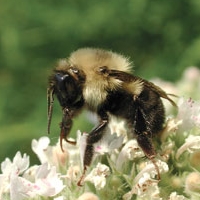Citizen Science Opportunities - Insects
Are you looking for an opportunity to volunteer your time helping wildlife? Are you willing to help collect data on species and their habitats? Maybe you want to teach others about fishing or hunting. Chapter 5 of the 2015 State Wildlife Action Plan lists education and outreach efforts as one of the fundamental strategies needing implementation in South Carolina to benefit priority wildlife species and their habitats. In particular, SCDNR and its partners should "promote volunteer participation, both in education and outreach programs as well as in data collection. [High priority]."
There are many opportunities for the public to help gather information that biologists and researchers can use in assessing species and their habitats. Sometimes our biologists need seasonal help with specific projects. That's when our volunteers become vitally important. Listed below are some citizen science weblinks. Some are for SCDNR programs while others take you to our conservation partners' websites.
Bumble Bees

- Report active bumble bee nests and create habitat for these declining pollinators.
- Take photographs of bees and share with experts at Bumble Bee Watch to help determine the range of various species.
- The Bumble Bee Atlas provides workshops to train citizen scientists to survey pre-determined grid cells for target bumble bee species of conservation concern and report findings online to Bumble Bee Watch.
- More information on how to help bumble bees can be found back on the Xerces Site at https://xerces.org/bumblebees/get-involved.
Butterflies and Moths

- Send in your Lepidoptera (order of insects that includes moths and butterflies) sightings and photographs to the Butterflies and Moths of North America (BAMONA) database.
- Assist with butterfly tagging through the Carolina Butterfly Society
- Participate in the Monarch Watch Tagging Program every fall to help scientist get a better understanding of monarch’s migration patterns.
- Did you know that monarch caterpillars only eat from a milkweed plant to grow into a butterfly? Help monarch caterpillars and adult monarchs by planting native milkweed plants and other native nectar-rich wildflowers. Planting native helps the environment, wildlife and is less maintenance for the gardener. View a nectar plant list and visit a South Carolina nursey that sells native plants.
- Assist the University of Minnesota in their nationwide study of monarch butterfly ecology through the Monarch Larva Monitoring Program.
- Winter Monarch Butterfly Tagging Project - Monarch butterfly populations are decreasing, with record low winter counts for Mexico in 2014. Many of the monarchs migrate from Mexico to the upper Midwest and southern Canada during the summer and then back to Mexico in the fall. But on the East coast, things are different. Monarchs migrating along the East coast in fall typically do not go to Mexico. Some over-winter along the immediate coast of South Carolina. Scientists want to find out more about this winter range along the Lowcountry coast.
- Check out all the ways you can participate in National Moth Week, July 20-28, 2019.
Dragonflies
- Join the Migratory Dragonfly Partnership (MDP) in tracking five species of migratory dragonflies and the habitats they utilize..
 Assist the Xerces Society for Invertebrate Conservation with their study of dragonflies by participating in
Pond Watch and Migration Monitoring programs.
Assist the Xerces Society for Invertebrate Conservation with their study of dragonflies by participating in
Pond Watch and Migration Monitoring programs.
Fireflies
- The Firefly Atlas provides a training video to teach citizen scientists how to submit incidental sightings of fireflies or conduct full surveys for the 13 focus species of conservation concern and report them online.
